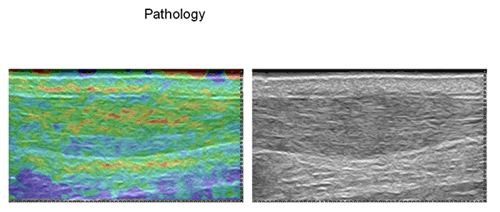Elastography breaks new ground in musculoskeletal imaging
Researchers from Egypt and Austria are taking a leap of faith to evaluate several possible ultrasound elastography applications in musculoskeletal radiology. Everyone from weekend warriors to elite athletes may benefit if the test is proven effective, according to papers released Monday at the RSNA meeting.
Researchers from Egypt and Austria are taking a leap of faith to evaluate several possible ultrasound elastography applications in musculoskeletal radiology. Everyone from weekend warriors to elite athletes may benefit if the test is proven effective, according to papers released Monday at the RSNA meeting.
Musculoskeletal radiologists seem keen on moving toward more quantitative, functional studies. But they need the right imaging tools to explain how MSK structures work instead of simply describing their appearance. Elastography -- performed by ultrasound or MRI -- emerged as a way to characterize the mechanical properties of tissue. It has been praised as a useful diagnostic tool in breast, prostate, cervix, and thyroid applications.
Now musculoskeletal radiologists could also use real-time sonoelastography for diagnosis of tissue softening or tears of heel, elbow, and shoulder tendons.
Dr. Tobias De Zordo and colleagues at the Medical University of Innsbruck in Austria used sonoelastography to evaluate Achilles tendons. The investigators enrolled 25 patients with chronic tendinopathy and 25 healthy subjects who underwent a clinical exam and both standard and elastography ultrasound. They found that elastography could be just as accurate as standard ultrasound to detect tendon abnormalities in symptomatic as well as asymptomatic patients.
"Clinical differentiation between tendinopathies and other debilitating conditions is sometimes difficult. Sonoelastography showed good sensitivity and specificity in the detection of alterations of Achilles tendinopathy in good correlation with conventional ultrasound," De Zordo said.
In another study, the same group used sonoelastography to assess 32 patients previously diagnosed with lateral epicondylitis and 28 healthy volunteers. They compared results with those of the clinical exam plus standard and Doppler sonography.
Sonoelastography provided sensitivity, specificity, accuracy, and positive and negative predictive values of 100%, 89%, 94%, 88%, and 100%, respectively, compared with 95%, 89%, 91%, 88%, and 95% for conventional sonography. Findings suggest that elastography could work as a diagnostic adjunct to power Doppler for a more detailed assessment of patients presenting with elbow tendon lesions.
Researchers from Egypt used sonoelastography to assess the upraspinatus tendon in healthy volunteers and patients complaining of shoulder pain. They compared results with MRI and found that sonoelastography was a sensitive method for diagnosis of rotator cuff tears.
Further studies will tell how effective sonoelastography would be in diagnosing pathology, said session chair Dr. Jon A. Jacobson. Researchers need to define the diagnostic and prognostic benefit of elastography over gray-scale, color, or power Doppler imaging.
"There are potential applications," Jacobson told Diagnostic Imaging. "What remains to be seen is how much of that can be used clinically."

What New Research Reveals About Novice Use of AI-Guided Cardiac Ultrasound
April 4th 2025In a study recently presented at the American College of Cardiology (ACC) conference, researchers found that novice use of AI-guided cardiac ultrasound after an AI-enabled electrocardiogram increased the positive predictive value for reduced left ventricular ejection fraction (LVEF) or aortic valve stenosis by 33 percent.
The Reading Room: Racial and Ethnic Minorities, Cancer Screenings, and COVID-19
November 3rd 2020In this podcast episode, Dr. Shalom Kalnicki, from Montefiore and Albert Einstein College of Medicine, discusses the disparities minority patients face with cancer screenings and what can be done to increase access during the pandemic.
New AI-Enabled Portable Ultrasound May Facilitate 50 Percent Reduction in Cardiac Imaging Scan Time
March 28th 2025Artificial intelligence (AI)-powered measurement capabilities provide key features with the Compact Ultrasound 5500CV device, which was unveiled at the American College of Cardiology (ACC) conference.










